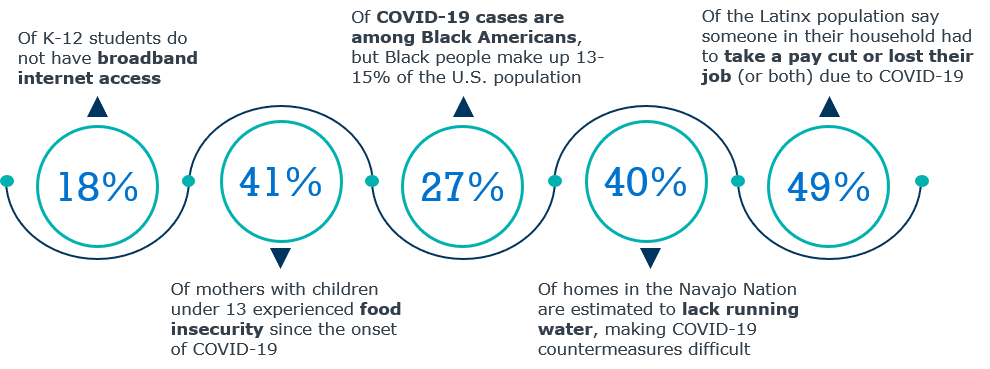K-12 Equity Self-Assessment and Implementation Guide
Addressing the inequitable impact of your district’s or school's policies and practices on BIPOC students
Equality—where every student has the same access, opportunities, and resources—has long been at the center of educational strategy and planning. But equality itself cannot address the specific needs of BIPOC (Black, Indigenous, People of Color) and/or low-income students, who have been disenfranchised by decades of systemic racism and severely impacted by the COVID-19 pandemic. Equity, where K-12 school leaders and educators recognize and meet the different needs of their students, is the key to dismantling systemic injustices prevalent in every community.
A commitment to equity in students’ school experiences and outcomes is necessary for districts and schools to prepare for a hard reset, but it requires critical examination of institutional policies and practices that negatively affect Black, indigenous, ethnic minorities, and other historically underserved student groups.
Use EAB’s equity assessment to determine if you have the policies and practices in place at your district or school to support these students and commit to next steps. Choose between “School districts” and “Independent schools” to view the equity assessment and strategies that work best for your institution type.
-
School districts
-
Independent schools
School districts
The COVID-19 pandemic has disproportionately affected and exacerbated existing inequalities for BIPOC (Black, Indigenous, People of Color) and low-income communities that will have ramifications well beyond the pandemic.

Furthermore, nationwide demands for racial justice have shed new light on racial inequities persistent between white Americans and BIPOC, which has contributed to significant inequities in education today. In schools, racial inequity is seen through self-segregated school communities from decades of failed Brown v. Board of Education integration initiatives, the persistence of the school-to-prison pipeline for Black youth, and significant barriers (such as inequitable access to advanced courses) that keep Black students from persisting in college in rates comparable to their white peers.
With the COVID-19 pandemic disproportionately impacting BIPOC and low-income communities, it is impossible for schools to go back to the “normal” from before the pandemic, in which BIPOC and low-income students were persistently behind their peers.
Section 1 of this resource is a self-assessment meant to be a comprehensive start—not an all-encompassing audit—for district leaders to prioritize strategies that promote student equity. Section 2 provides implementation guidance.
Assess your district’s strategies and plan next steps to promote an equitable school experience
We’ve outlined policies, practices, and strategies to support historically underserved students in your district. These strategies are meant to be used by district or school leaders with decision-making power, who can address each equity area.
To get the most out of this resource, we suggest you first download the equity self-assessment as a PDF. Then, take time to explore the strategies in section 2 and use the tools provided throughout to mitigate non-academic barriers to equitable student success, create inclusive educational environments, and support post-secondary student success.
Independent schools
Spring and summer 2020 will be remembered nationally for the renewed attention to anti-Black racism and police brutality in this country in the wake of George Floyd’s murder in Minnesota and the ongoing response to COVID-19. But, for independent schools it will also be remembered for the radical impact of former and current Black students sharing their experiences with micro- and macro- aggressions on campus and calling attention to their schools’ culture of racism.
Black, Indigenous, and People of Color (BIPOC) students and families are looking to their schools to build an inclusive and welcoming environment in which all students can be successful.
Nationwide, demands for racial justice have shed new light on racial inequities persistent between white Americans and BIPOC. Schools should not try to return to the “normal” from before this national reckoning, in which BIPOC students were persistently alienated by their schools. Instead, we recommend that independent schools take time to collect, reflect on, and respond to student activism and outrage. You must address systemic racism, work towards becoming anti-racist, and build more equitable institutions.
Section 1 of this resource is a self-assessment meant to be a comprehensive start—not an all-encompassing audit—for independent school leaders to prioritize strategies that promote student equity. Section 2 provides implementation guidance.
Assess your school’s existing strategies to promote an equitable school experience
Use this self-assessment section to evaluate the policies, practices, and strategies in place at your school to support BIPOC students. Please note that this assessment is meant to be used by school leaders with decision-making power, who can adequately address each equity area.
To get the most out of this resource, we suggest you first download the equity self-assessment as a PDF. Then, take time to explore the strategies in section 2 and use the tools provided throughout to mitigate non-academic barriers to equitable student success and create an inclusive, engaging, and diverse environment.
This resource requires EAB partnership access to view.
Access the research report
Learn how you can get access to this resource as well as hands-on support from our experts through District Leadership Forum.
Learn More